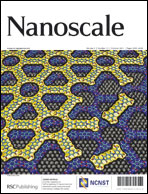We report the development of a novel magnetic nano-contrast agent (nano-CA) based on Gd3+ doped amorphous TiO2 of size ∼25 nm, exhibiting enhanced longitudinal relaxivity (r1) and magnetic resonance (MR) contrasting together with excellent biocompatibility. Quantitative T1 mapping of phantom samples using a 1.5 T clinical MR imaging system revealed that the amorphous phase of doped titania has the highest r1 relaxivity which is ∼2.5 fold higher than the commercially used CA Magnevist™. The crystalline (anatase) samples formed by air annealing at 250 °C and 500 °C showed significant reduction in r1 values and MR contrast, which is attributed to the loss of proton-exchange contribution from the adsorbed water and atomic re-arrangement of Gd3+ ions in the crystalline host lattice. Nanotoxicity studies including cell viability, plasma membrane integrity, reactive oxygen stress and expression of pro-inflammatory cytokines, performed on human primary endothelial cells (HUVEC), human blood derived peripheral blood mononuclear cells (PBMC) and nasopharyngeal epidermoid carcinoma (KB) cell line showed excellent biocompatibility up to relatively higher doses of 200 μg ml−1. The potential of this nano-CA to cause hemolysis, platelet aggregation and plasma coagulation were studied using human peripheral blood samples and found no adverse effects, illustrating the possibility of the safe intravenous administration of these agents for human applications. Furthermore, the ability of these agents to specifically detect cancer cells by targeting molecular receptors on the cell membrane was demonstrated on folate receptor (FR) positive oral carcinoma (KB) cells, where the folic acid conjugated nano-CA showed receptor specific accumulation on cell membrane while leaving the normal fibroblast cells (L929) unstained. This study reveals that the Gd3+ doped amorphous TiO2 nanoparticles having enhanced magnetic resonance contrast and high biocompatibility is a promising candidate for molecular receptor targeted MR imaging.

You have access to this article
 Please wait while we load your content...
Something went wrong. Try again?
Please wait while we load your content...
Something went wrong. Try again?


 Please wait while we load your content...
Please wait while we load your content...